How SOUNDS AUSTRALIA is helping Australian artists to break into new markets

Australia’s much-appreciated proponents of exporting Aussie music to the world, SOUNDS AUSTRALIA, were able to celebrate the last-minute securing of vital federal funding last year by launching a fact-finding mission into South America that sought to form valuable partnerships in the region, and learn what they could in an effort to help Australian artists to push into foreign markets.
As one of Australia’s most prominent organisations concerned with the export of Australian music, SOUNDS AUSTRALIA were supported by The Department of Foreign Affairs & Trade (DFAT) as they brought together a delegation of local industry figures to embark on the trip across the increasingly-important markets of Chile, Argentina and Brazil.
Carefully chosen to represent a cross-section of the music business, the full dream-team included Andrew Stone (Chugg Entertainment), Ashley Gay (Xelon Entertainment), Clara Iaccarino (Perth International Arts Festival), Jaime Gough (Native Tongue Music Publishing), Maggie Collins (BIGSOUND), Matthew Rogers (We Are Unified), Monique Rothstein (Positive Feedback), Scot Morris (APRA AMCOS), Stuart Rogers (Sydney Festival) and Warren Costello (Liberation Music).
For SOUNDS AUSTRALIA, the aims were clear.
“In order to establish and strengthen long-term, two-way business connections in South America, the team aims to identify and secure local partnerships, navigate and negotiate new markets, especially with respect to managing tour logistics, production and presentation values, promotion and marketing, along with media, community and audience engagement.
“Building these relationships is key to Australia’s success in these emerging markets over the coming years and the proposed SOUNDS AUSTRALIA South American Trade Mission will present a meaningful reconnaissance opportunity, setting a strong foundation for reciprocal business and cultural outcomes.”
Now, with the mission completed, we’ve spoken to SOUNDS AUSTRALIA’s Executive Producer Millie Millgate to get an in-depth account of how the trip went, what the group was able to achieve, and why – with the necessary funding being provided – further expeditions of this sort will play such an important role in expanding Australia’s place in the world of music, and provide greater opportunities for our artists and industry professionals beyond our talented but tiny corner of the world.
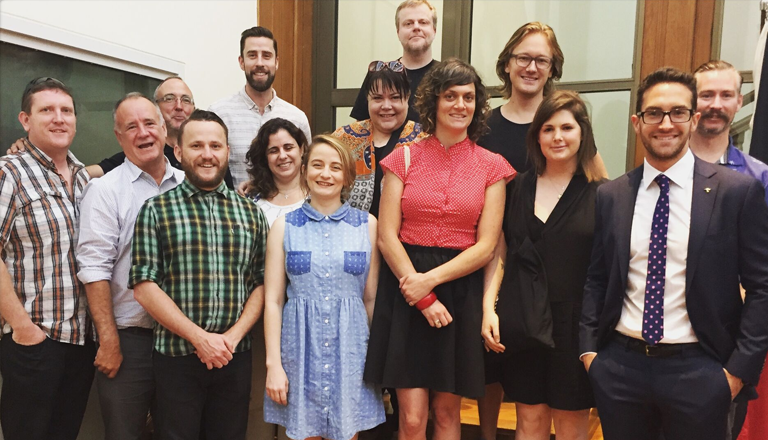
The team chosen by SOUNDS AUSTRALIA to represent Australia’s music industry in South America
The first mission of its kind
While SOUNDS AUSTRALIA has been working since 2009 to provide greater opportunities for Australian artists to perform overseas, running a variety of respected showcases in a range of countries, Millie explains that this recent effort was quite a bit different, and the first of its kind for the organisation.
“This was definitely the first for us,” Millie says. “Our remit to date has been to support Australian artists and industry that are already attending a showcase conference event. We do this by producing additional showcasing opportunities such as THE AUSSIE BBQ and SOUND GALLERY, coordinating networking events and undertaking promotion targeting the international tastemakers, industry and media.
“This activity has predominantly taken place at established music events in North America, the UK and Europe, where a known pathway – and access to the market via a showcase conference – was already developed, and delivering outcomes to participating international acts. The reconnaissance activity undertaken prior to investing in these events was as simple as attending and paying close attention to what was working for others and then devising an appropriate suite of activity for the Australians.
“we were absolutely certain that the time was ripe for export and that there were considerable untapped opportunities for Australian artists”
“What became very apparent after attending a few music industry events in South America from 2013 was that a more detailed understanding of the emerging market was required before SOUNDS AUSTRALIA could commit to investing any of its limited budget to the region. While we were absolutely certain that the time was ripe for export and that there were considerable untapped opportunities for Australian artists and music businesses across South America, it would need to be considered with a far more sophisticated and scrutinising lens.”
With these early brushes with South America indicating that the time had come to investigate the region more thoroughly, and for that further funding was required.
“There had never seemed a more apparent time or need for SOUNDS AUSTRALIA to lead a delegation of Australian industry professionals into the region in order to determine, from an experienced and credible brains trust, where the opportunities, if any, were – and what might still require further development. The only reason we were able to undertake this first ever Trade Mission, was due to funding through a successful DFAT Cultural Diplomacy Grant, which was awarded to develop an overarching strategy on how to access and penetrate the South American market in the coming years.
While it was the first mission of this sort, SOUNDS AUSTRALIA certainly hope it won’t be the last, with a host of opportunities left to explore both in South America and Asia – but it’s all a matter of funding.
“We don’t have any upcoming Trade Missions planned,” Millie says. “However if we can secure the funding we believe it’s an incredibly effective and strategic method of approaching international music markets with a whole of industry approach, especially the emerging markets of South America and Asia. I also think there’s a lot of merit in leading an Australian Trade Mission to cross-media events across gaming, film and television in the future.”
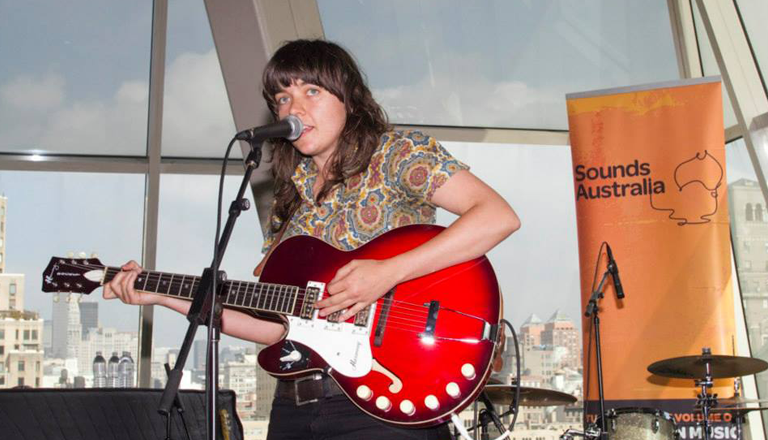
Courtney Barnett made the trip to perform in NYC several years back, before her profile blew up internationally
An all-star team of Australian music talent
That “whole of industry approach” was one of the distinguishing factors of the mission, with SOUNDS AUSTRALIA seeking to represent the interests of our local music industry as fairly as it could – and with a certain degree of authority among the members.
“It was really important that the delegation represented as many sectors of the Australian music industry as possible,” Millie explains. “This also meant factoring in those who wore multiple hats, such as a manager/label/publicist, and people from companies that also represented more than one sector, such as Unified, Chugg Music and Liberation as part of the Mushroom Group.
“Another deciding factor in selecting the potential delegates was that, while they didn’t have to be the CEO, they certainly needed to have decision-making capabilities within their company. In addition and in order to disseminate and share our collective findings, I was after people that also held board positions on key industry organisations, so that the experience and subsequent discoveries and opportunities could be reported upon directly and efficiently to the wider Australian music industry.
“A good mix of diverse genre expertise was sought among the delegation, and… I was very conscious of not just taking a group of ‘sellers’ in to the market”
“Among the delegation, there were three Directors of AIR (Independent Labels Association), one director of AMPAL (Australian Music Publishers Association Limited), one from AMCOS (Australasian Mechanical Copyright Owners Society Limited), two directors of the AAM (Association of Artist Managers), and Senior Management from APRA (Australasian Performance Right Association).
Crucially, the diversity had to extend beyond the organisations involved, and also take into account the reciprocal nature of the mission and the opportunities for trade in both directions.
“A good mix of diverse genre expertise was sought among the delegation, and then finally I was very conscious of not just taking a group of ‘sellers’ in to the market,” Millie points out. “Reciprocity is a crucial component of successful trade, and as such it was important for SOUNDS AUSTRALIA to bring with us potential ‘buyers’ that were in a position to offer opportunities in Australia to South American artists – hence the inclusion of the programmers from BIGSOUND, Sydney Festival and Perth International Arts Festival.”
When laid out in graph form, the delegation ticks as many boxes as could reasonably be expected of it, managing to represent a range of interests.
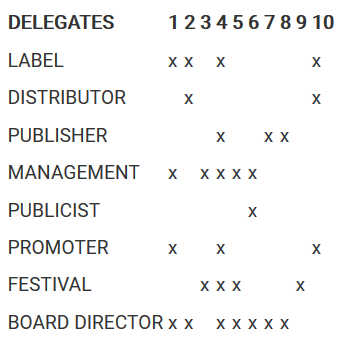
A lot of thought went in to gathering a wide variety of representatives
Securing partnerships for Aussie music
One of the primary aims of the mission was to form partnerships and build relationships with the South American market, and Millie explains the purpose of these partnerships, and why they’re so important for Australian acts going forward.
“When looking to export to any country, a huge determiner of an artist’s success often comes down to the local partners they are able to engage in advance of releasing in and/or touring a new country.
“These partners might include a combination of the following; booking agent, record label, distributor, radio plugger, promoter, publicist, publisher, digital strategist. By securing any of the above local partners, Australian artists are provided with the advantage of exploiting existing relationships their partners have, guilt by association (in a good way), local knowledge in relation to media cycles and release timeframes and a much more extensive understanding of how the respective music industry in each country functions.
“These identified partners are particularly important in non-English speaking countries, often just to act as an intermediary between the Australian Acts, media and audience becomes so essential.
While the nature of many of these partnerships is still being solidified behind closed doors, Millie is confident of what the group were able to achieve, and just how quickly the mission will pay off.
“I can categorically state that partnerships were developed as a result of the inaugural South American Trade Mission and we’ll be seeing those in action within the next 6-12 months.”
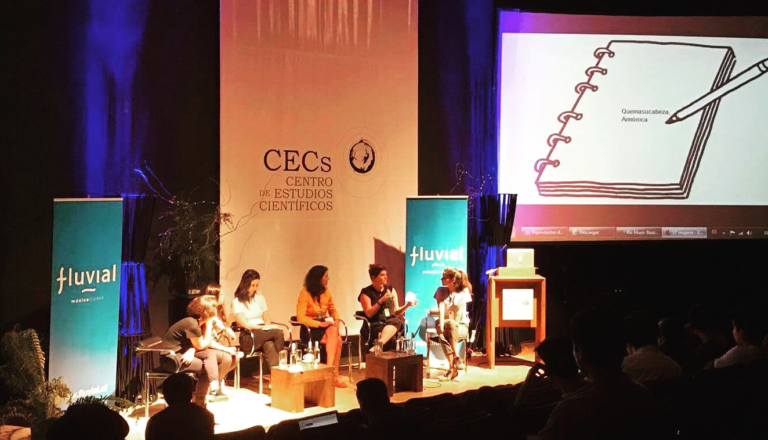
Monique sitting on a ‘Women In Music’ panel in Valdivia, Chile, alongside Francisca Venezuela, one of its biggest pop acts
The most valuable moments
With a wide range of different events, workshops and meetings taking place throughout the trip, which proved to be the most valuable to the group?
“Honestly, I think it was the combination of all three,” Millie says. “The workshops and/or conference panel sessions provided a really terrific and thorough overview of the local scenes and a snapshot of their respective operating environments. It was also a great way to determine some of the key “go to” people in each country and how developed and sophisticated each market is.
Sometimes, the group was able to achieve a lot in very little time, and it wasn’t all formality.
“The coordinated speed meetings that were undertaken by the delegates at all four conferences (literally hundreds between them) were a very efficient way to identify future possible partners and, like the panels, present an overview of the experience level of participants and thus the potential value of each conference going forward.
“The numerous events, such as openings, showcases, cocktail mixers, a studio launch, industry dinners and a lunchtime pool party all provided hours of more informal meet and greet opportunities for the Australian delegation. It was during these events that many of the more significant relationships throughout the trip were established and consolidated.”
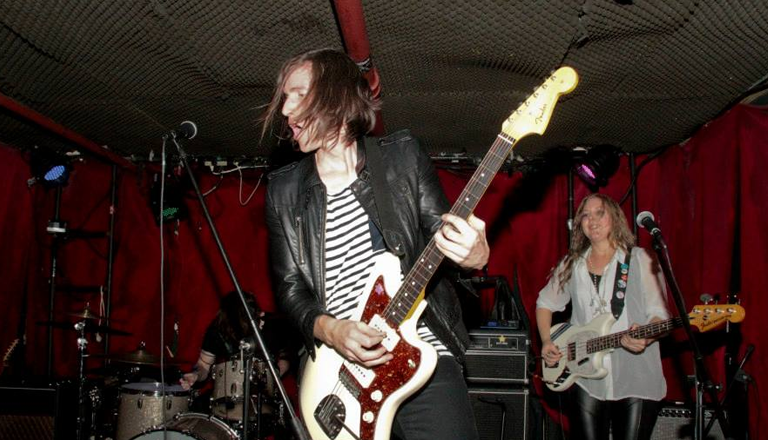
The Aussie BBQ at CMJ music conference gave Australian bands the chance to play to industry in New York City
Learning from different markets
Having covered so much ground across South America, it became clear just how varied the market there really is, with the delegation finding pronounced differences between the three countries visited.
“The differences between Chile, Argentina and Brazil were far more significant than first thought and or ever imagined,” Millie explains. “As such, it really is essential to approach them as different territories, rather than making the mistake of tackling it as one region and all in exactly the same way.
“Our experience allowed us to witness an incredibly supportive and unified music community developing in Chile. It was exciting and inspiring to see the number of different industry trade associations and sectors working together along with local, state and national government (including arts, trade and tourism portfolios). The launch of a national Chilean music policy and plan during the first edition event Fluvial, in Valdivia, was amazing to be privy to. There’s definitely an exciting evolution happening in Chile for the music industry.
“Even though many successful and prominent music industry professionals reside in Argentina, the overall music community felt very fragmented, with no cohesive strategy, coordinated plan or collective goals. There was far more government intervention and control over their industry conference BAFIM, and red tape associated with its presentation and in particular the short lead time in which the event was announced.
“Despite sharing the same language and geographic proximity, there was a surprising lack of collaboration… which for us, coming from a country the size of Australia, was difficult to understand”
“Despite sharing the same language and geographic proximity, there was a surprising lack of collaboration and partnering on projects between Chilean and Argentinean artists and the wider industry, which for us, coming from a country the size of Australia, was difficult to understand. I think we all expected there to be much more of a connection between the two countries.
Brazil, however, proved a little different in scope to either Argentina or Chile, Millie explains – and also to Australia.
“It was always a given that Brazil would be completely different to the other two countries visited on the Trade Mission, with a different language and a relatively strong and self contained local market. The music industry overall is considerably more advanced and established compared to its other South American counterparts. The music industry conference SIM Sao Paulo was substantially bigger and more comprehensive, now in its fourth year, drawing significant attendance and key industry participation.
“That said, Rio Music Buzz held the following week in Rio de Janerio was focused at a much more elementary level with respect to the panels, speed networking and showcasing activity.
“Interestingly with Brazil, with such a self-sufficient and strong domestic market, there is not the same need to export as there is for Australian artists. With a music loving population of over 204,451,000, they don’t need to be as aggressive in creating international opportunities and any potential reciprocal arrangements aren’t as embraced as they might be, compared to acts from other territories.”
The differences in funding and Government intervention in the countries’ music policies, as well as other socioeconomic concerns, led to some interesting findings as far as each country’s touring artists is concerned.
“The social, political and economic climates of each of the three countries also differ considerably between them and significantly to that of Australia,” Millie explains. “By association then, the financial capacity to tour internationally and seek career opportunities abroad is far more challenging for those artists from Argentina and to a lesser extent Brazil.
“This… does however provide a terrific opportunity for Australian artists to potentially pioneer such a touring route.”
“The aforementioned commitment to a music policy highlights that Chilean artists are far more likely than their Argentinean and Brazilian counterparts to receive Government funding and on the ground support in foreign markets for their music export endeavors.”
The touring market across the countries is fragmented, but this could lead to a significant opportunity for Australian artists to press into the South American market themselves.
“Collectively we learned that there were not that many South American artists currently working across all South American countries,” Millie claims. “There are no established touring routes between key cities and often artists will head to the UK, Europe or USA before touring to another South American city.
“This intriguing lack of existing infrastructure does however provide a terrific opportunity for Australian artists to potentially pioneer such a touring route.”

Maggie Collins sitting on a radio panel at SIM San Paulo, Brazil – casually repping triple j
More similar than different
With such significant socioeconomic differences between the three countries, there must surely be some philosophical differences as well. With political and societal issues such as gender equality or mental health in music being so important in Australia, are any of these issues also focused on in South America?
“Gender equality is definitely an important issue with respect to both Chile and Brazil and in fact both held Women in the Music Industry panels and a workshop during their respective conferences,” Millie replies. “The session in Chile included one of the biggest Chilean artists, Francisca Valenzuela, along with Monique Rothstein from Positive Feedback representing Australia.
“I particularly liked the description for the panel in Brazil that included: ‘There are many out there and, unfortunately, we cannot fit them all into one table. Not that they need prominence to legitimize their talents. We just think they deserve their recognition. A tribute from SIM São Paulo to all the super-powered women of the music market in Brazil.'”
Bringing it back to the music industry, are there any philosophical differences between us in how music and music professionals are viewed?
“One overarching theme we experienced in Chile, Argentina and Brazil was the philosophical love of, respect for, and importance music held in their respective cultures,” Millie says. “People of all ages, genders, persuasion, ethnicities and economic standing all seemed to enjoy and consume music en masse.”
Opportunities for Aussie acts
Ultimately, the results of this trip boil down to what sort of benefits will be seen by Australian acts, and Millie details some of the promotional opportunities the delegation has spotted in South America – and some of the genres that may have an easier path.
“When looking at specific types and genres of music that resonate particularly well, in Chile, Argentina and Brazil it’s fair to say that trends and cues tend to be coming from Mexico. Artists that are having success there can almost always parlay those results into traction in other South American territories.
“It’s certainly Australian dance acts, underground punk/psych and indie rock who are best served to be looking at this exciting emerging market. Unlike North America, it also seems like there might be different and more opportunity for “Aussie” hip-hop. Watch this space.”
The group also recognised that the region may be neglected by international touring acts because they aren’t seeing all of the promotional opportunities that exist in the region.
“As one of the Australian delegates noted – we have often heard that Brazil, Argentina and Chile are skipped on international album tours because the costs are too prohibitive. However since the Trade Mission, we learnt that the TV and radio opportunities would have been made available relatively easily by the local labels if the artist had simply shown up (since the competition for the spots isn’t as high).
“A big part of the Mission was to meet different people and identify potential teams who can facilitate these promotional opportunities for Australian artists in the future.”
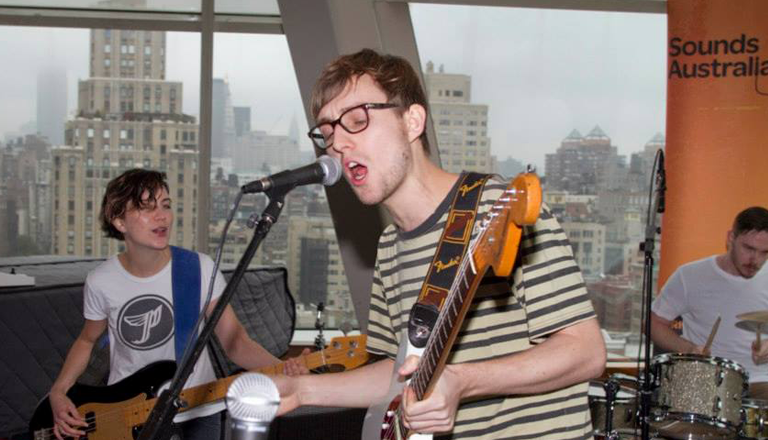
SOUNDS AUSTRALIA’s international showcases have given bands like Ball park Music opportunities to break into overseas markets
The future for SOUNDS AUSTRALIA
While the potential certainly exists to gain an even greater insight into foreign markets for the benefit of our artists, SOUNDS AUSTRALIA won’t be able to provide that unless it can secure its own future first. After a serious scare last year when funding for the organisation was suddenly removed, it was eventually able to secure further funding to allow it to continue for several more years.
“We are still so incredibly grateful for all the support shown by the Australian and international music industry,” Millie says, “especially the Australian artists that have showcased with us over the last eight years.”
Millie details further the current funding situation, and what needs to happen to ensure the future of SOUNDS AUSTRALIA.
“Arts funding across the board took a beating in 2015/2016 and we are very mindful of how many organisations are still in limbo, or worse, shutting their doors and thus we don’t take the support we’ve been allocated for the next four years from both the Department of Communications and the Arts and the Australia Council, either lightly or for granted.
“We’re really excited about getting stuck into 2017 without that dark cloud hanging over us.”
“We’ve also received ongoing support during this time from the State Governments of New South Wales, Queensland, South Australia and Victoria which has been crucial; and the industry partners have been unwavering in their commitment, led by APRA AMCOS, along with PPCA and AMPAL.”
The situation remains uncertain, but SOUNDS AUSTRALIA is at least able to make its plans for the next few years, and continue to build a case for continued funding through valuable initiatives like its South American mission.
“For now we just want to put our heads down,” Millie says. “We’re really excited about getting stuck into 2017 without that dark cloud hanging over us. The reality of potentially losing half our program has made us really scrutinize all of our market events and activity undertaken and in some instances there will be significant changes made.
“We will continue to be part of the ARC research team that is investigating The Economic and Cultural Value of Australian Music Export in partnership with the Universities of Newcastle and Monash, APRA AMCOS and the Australian Council for the Arts, and we’re hopeful that the results will provide independent and concrete evidence of the value of service provided by SOUNDS AUSTRALIA that will ultimately lead to policy development and a budget estimates commitment for the national export initiative.”
One thing we’re sure of is that, for the many talented and eminently marketable artists we can proudly claim in this country, an organisation finding pathways for them to break into new territories is an incredibly valuable asset.
This article originally appeared on The Industry Observer, which is now part of The Music Network.






























